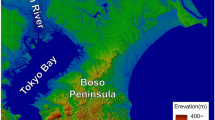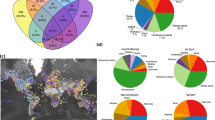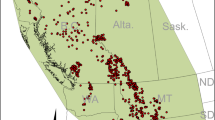Abstract
Invasions and subsequent range expansions by exotic species provide an excellent opportunity for the study of founder effects on the genetic structure of colonizing populations. Although the Great Lakes have served as the initial point of colonization for more than 100 species, few studies have examined the genetic structure of these invaders. This study shows that levels of genetic variability in North American populations of the cladoceran invader Bosmina coregoni are at least as high as those in European populations, suggesting that founding populations were large. As allelic diversity in North America is higher than in any single European population, the Great Lakes have probably been colonized repeatedly. In the past 30 years, B. coregoni has expanded its range into inland lakes within 100 km of the Great Lakes, through both long-distance dispersal and migration among neighbouring lakes. Although these secondary invasions have produced little reduction in genetic diversity, they have led to pronounced gene frequency divergence among populations from inland North American lakes.
Similar content being viewed by others
Article PDF
References
Archie, J W. 1985. Statistical analysis of heterozygosity data: independent sample comparisons. Evolution, 39, 623–637.
Avise, J C. 1975. Systematic value of electrophoretic data. Syst Zool, 23, 465–481.
Baker, A J. 1992. Genetic and morphometric divergence in ancestral European and descendent New Zealand populations of chaffinches (Fringilla coelebs). Evolution, 46, 1784–1800.
Baker, A J, and Mooed, A. 1987. Rapid genetic differentiation and founder effect in colonizing populations of common mynas (Acridotheres tristis). Evolution, 41, 525–538.
Balcer, M D, Korda, N L, and Dodson, S I. 1984. Zooplankton of the Great Lakes A Guide to the Identification of the Common Crustacean Species. University of Wisconsin Press, Wisconsin.
Boileau, M G, and Hebert, P D N. 1991. Genetic consequences of passive dispersal in pond-dwelling copepods. Evolution, 45, 721–733.
Boileau, M G, and Hebert, P D N. 1992. Genetics of the zebra mussel, Dreissena polymorpha, in populations from the Great Lakes region and Europe. In: Nalepa, T. F. and Schloesser D. W. (eds) Zebra Mussels: Biology, Impacts and Control, pp. 227–238. Lewis Publishers, Michigan.
Browne, R A. 1977. Genetic variation in island and mainland populations of Peromyscus leucopus. Am Midl Nat, 97, 1–9.
Bryant, E H, Van Dijk, H, and Van Delden, W. 1981. Genetic variability of the face fly, Musca autumnalis De Geer, in relation to a population bottleneck. Evolution, 35, 872–881.
Carson, H L. 1967. The population flush and its genetic consequences. In: Lewontin, R. C. (ed.) Population Biology and Evolution, pp. 123–138. Proceedings of the International Symposium, Syracuse University Press, New York.
Carter, J C H, Dadswell, M J, Roff, J C, and Sprules, W G. 1980. Distribution and zoogeography of planktonic crustaceans in glaciated eastern North America. Can J Zool, 58, 1355–1387.
Coyne, J A, and Barton, N H. 1988. What do we know about speciation? Nature, 33, 485–486.
Deevey, E S, Jr, and Deevey, G B. 1971. The American species of Eubosmina Seligo (Crustacea, Cladocera). Limnol Oceanogr, 16, 201–218.
Demelo, R. 1993. Speciation in the Freshwater Zooplankton: Provincialism in the Bosminidae. M.Sc. Thesis, University of Guelph.
Demelo, R, and Hebert, P D N. 1994. Allozymic variation and species diversity in North American Bosminidae. Can J Fish Aquat Sci, 51, 873–880.
Environment Canada. 1988. The Great Lakes: An Environmental Atlas and Resource Book. United States Environmental Protection Agency and Environment Canada.
Environmental Protection Service. 1981. The Presence and Implication of Foreign Organisms in Ship Ballast Waters Discharged into the Great Lakes, vols I–II. Environment Canada.
Havel, J E, and Hebert, P D N. 1993. Daphnia lumholtzi in North America: another exotic zooplankter. Limnol Oceanogr, 38, 1823–1827.
Hebert, P D N. 1974. Enzyme variability in natural populations of Daphnia magna. I. Population structure in East Anglia. Evolution, 28, 546–556.
Hebert, P D N. 1987. Genetics of Daphnia. In: Peters, R. H. and de Bernardi, R. (eds) ‘Daphnia’ Mem 1st Ital Idrobiol, 45, 439–460.
Hebert, P D N, and Beaton, M J. 1989. Methodologies for Allozyme Analysis using Cellulose Acetate Electrophoresis. Helena Laboratories, Texas.
Hebert, P D N, and Payne, W J. 1985. Genetic variation in populations of the hermaphroditic flatworm Mesostoma lingua (Turbellaria, Rhabdocoela). Biol Bull, 169, 143–151.
Janson, T. 1987. Genetic drift in small and recently founded populations of the marine snail Littorina saxatalis. Heredity, 58, 31–37.
Johnson, M S. 1988. Founder effects and geographic variation in the land snail Theba pisana. Heredity, 61, 133–142.
Lessa, E P. 1990. Multidimensional analysis of geographic genetic structure. Syst Zool, 39, 242–252.
Lieder, U. 1991. The Bosmina kessleri-like morphotype of Eubosmina in Lake Muskoka, Ontario, Canada, as putative interspecific hybrids. Hydrobiologia, 225, 71–80.
Mayr, E. 1963. Animal Species and Evolution. The Belknap Press of Harvard University Press, Massachusetts.
Mills, E L, Leach, J H, Carlton, J T, and Secor, C L. 1991. Exotic Species in the Great Lakes: A History of the Biotc Crises and Anthropogenic Introductions. Great Lakes Fishery Commission Research Completion Report.
Nei, M, Maruyama, T, and Chakraborty, R. 1975. The bottleneck effect and genetic variability in populations. Evolution, 29, 1–10.
Parkin, D P, and Cole, S R. 1985. Genetic differentiation and rates of evolution in some introduced populations of the House Sparrow, Passer domesticus in Australia and New Zealand. Heredity, 54, 15–23.
Rogers, J S. 1972. Measures of genetic similarity and genetic distance. Studies in Genetics, 7, 145–153.
Ross, H A. 1983. Genetic differentiation of starling (Sturnus vulgaris: Aves) populations in New Zealand and Great Britain. J Zool Lond, 201, 351–362.
Ross, K G, and Trager, J C. 1990. Systematics and population genetics of fire ants (Solenopsis saevissima complex) from Argentina. Evolution, 44, 2113–2134.
Sokal, R R. 1979. Testing statistical significance of geographic variation patterns. Syst Zool, 28, 227–232.
Swofford, D L, and Selander, R B. 1981. BIOSYS-1: A Computer Program for the Analysis of Allelic Variation in Genetics. Users Manual. University of Illinois at Urbana-Champaign, Urbana, Illinois.
Taylor, C E, and Gorman, G C. 1975. Population genetics of a ‘colonizing’ lizard: natural selection for allozyme morphs in Anolis grahami. Heredity, 35, 241–247.
Taylor, D J, and Hebert, P D N. 1993. Habitat-dependent hybrid parentage and differential introgression between neighboringly sympatric Daphnia species. Proc Natl Acad Sci USA, 90, 7079–7083.
Templeton, A R. 1980. The theory of speciation via the founder principle. Genetics, 94, 1011–1038.
Ward, R D. 1977. Relationship between enzyme heterozygosity and quaternary structure. Biochem Genet, 15, 123–135.
Weider, L J. 1989. Population genetics of Polyphemus pediculus (Cladocera: Polyphemidae). Heredity, 62, 1–10.
Weider, L J. 1991. Allozymic variation in Bythotrephes cederstroemi: a recent invader of the Great Lakes. J Great Lakes Res, 17, 141–143.
Weir, B S, and Cockerham, C C. 1984. Estimating F-statistics for the analysis of population structure. Evolution, 38, 1358–1370.
Wells, L. 1970. Effects of alewife predation on Zooplankton populations in Lake Michigan. Limnol Oceanogr, 15, 556–565.
Woodruff, D S, Mulvey, M, and Yipp, M W. 1985. Population genetics of Biomphalaria straminea in Hong Kong. J Heredity, 76, 355–360.
Workman, P L, and Niswander, J D. 1970. Population studies on southwestern Indian tribes. II. Local genetic differentiation in the Papago. Am J Hum Genet, 22, 24–49.
Yan, N D, Dunlop, W I, Pawson, T W, and Mackay, L E. 1992. Bythotrephes cederstroemi (Schoedler) in Muskoka lakes: first records of the European invader in inland lakes in Canada. Can J Fish Aquat Sci, 49, 422–426.
Zar, J H. 1984. Biostatistical Analysis, 2nd edn., pp. 126–131. Prentice Hall, New Jersey.
Author information
Authors and Affiliations
Rights and permissions
About this article
Cite this article
Demelo, R., Hebert, P. Founder effects and geographical variation in the invading cladoceran Bosmina (Eubosmima) coregoni Baird 1857 in North America. Heredity 73, 490–499 (1994). https://doi.org/10.1038/hdy.1994.147
Received:
Issue date:
DOI: https://doi.org/10.1038/hdy.1994.147
Keywords
This article is cited by
-
The Intercontinental phylogeography of neustonic daphniids
Scientific Reports (2020)
-
An illustrated guide to the identification of cladoceran subfossils from lake sediments in northeastern North America: part 1—the Daphniidae, Leptodoridae, Bosminidae, Polyphemidae, Holopedidae, Sididae, and Macrothricidae
Journal of Paleolimnology (2012)
-
Biological Invasions Across Spatial Scales: Intercontinental, Regional, and Local Dispersal of Cladoceran Zooplankton
Biological Invasions (2006)
-
Colonization of Europe by two American genetic types or species of the genus Marenzelleria (Polychaeta: Spionidae). An electrophoretic analysis of allozymes
Marine Biology (1996)
-
Evolutionary and ecological consequences of interspecific hybridization in cladocerans
Experientia (1995)



